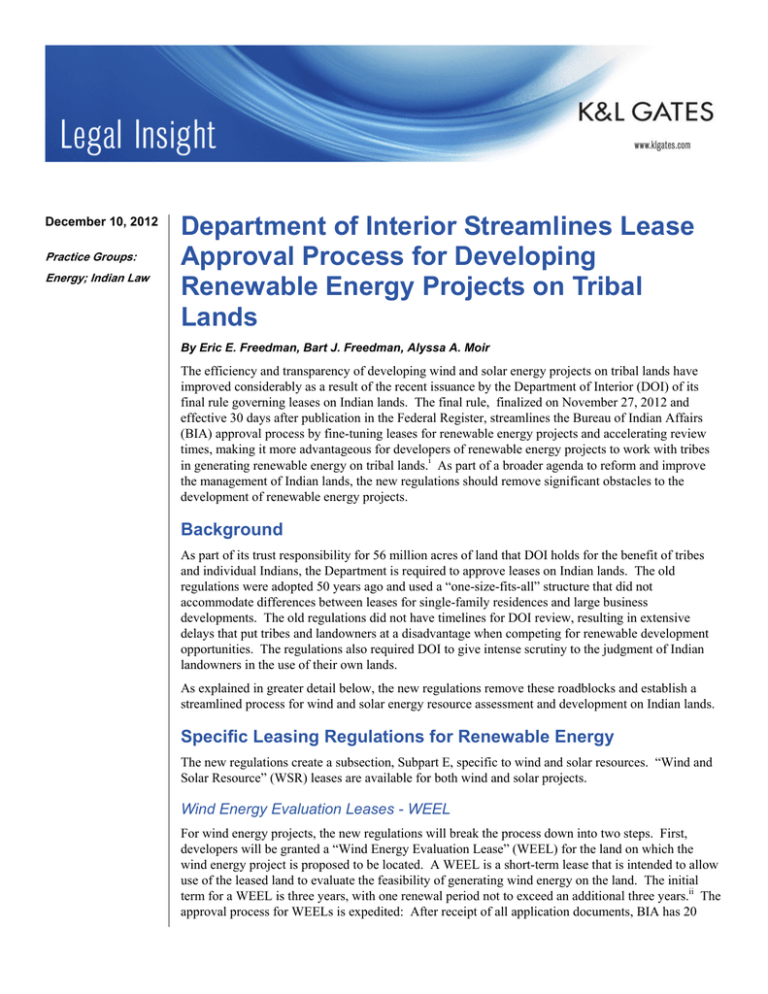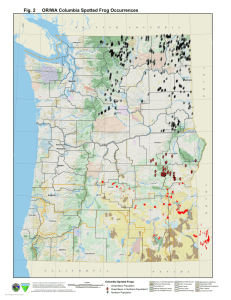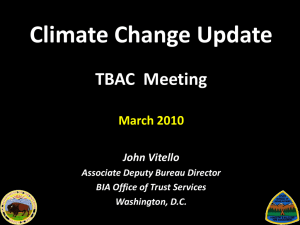Department of Interior Streamlines Lease Approval Process for Developing
advertisement

December 10, 2012 Practice Groups: Energy; Indian Law Department of Interior Streamlines Lease Approval Process for Developing Renewable Energy Projects on Tribal Lands By Eric E. Freedman, Bart J. Freedman, Alyssa A. Moir The efficiency and transparency of developing wind and solar energy projects on tribal lands have improved considerably as a result of the recent issuance by the Department of Interior (DOI) of its final rule governing leases on Indian lands. The final rule, finalized on November 27, 2012 and effective 30 days after publication in the Federal Register, streamlines the Bureau of Indian Affairs (BIA) approval process by fine-tuning leases for renewable energy projects and accelerating review times, making it more advantageous for developers of renewable energy projects to work with tribes in generating renewable energy on tribal lands.i As part of a broader agenda to reform and improve the management of Indian lands, the new regulations should remove significant obstacles to the development of renewable energy projects. Background As part of its trust responsibility for 56 million acres of land that DOI holds for the benefit of tribes and individual Indians, the Department is required to approve leases on Indian lands. The old regulations were adopted 50 years ago and used a “one-size-fits-all” structure that did not accommodate differences between leases for single-family residences and large business developments. The old regulations did not have timelines for DOI review, resulting in extensive delays that put tribes and landowners at a disadvantage when competing for renewable development opportunities. The regulations also required DOI to give intense scrutiny to the judgment of Indian landowners in the use of their own lands. As explained in greater detail below, the new regulations remove these roadblocks and establish a streamlined process for wind and solar energy resource assessment and development on Indian lands. Specific Leasing Regulations for Renewable Energy The new regulations create a subsection, Subpart E, specific to wind and solar resources. “Wind and Solar Resource” (WSR) leases are available for both wind and solar projects. Wind Energy Evaluation Leases - WEEL For wind energy projects, the new regulations will break the process down into two steps. First, developers will be granted a “Wind Energy Evaluation Lease” (WEEL) for the land on which the wind energy project is proposed to be located. A WEEL is a short-term lease that is intended to allow use of the leased land to evaluate the feasibility of generating wind energy on the land. The initial term for a WEEL is three years, with one renewal period not to exceed an additional three years.ii The approval process for WEELs is expedited: After receipt of all application documents, BIA has 20 Department of Interior Streamlines Lease Approval Process for Developing Renewable Energy Projects on Tribal Lands days in which to approve the application, disapprove the application, return the submission for revision, or notify the parties that BIA needs additional time. This is a significant improvement over the past process, in which lengthy review times conflicted with the need for developers to move quickly. Even so, some commenters have suggested that the 20- to-50-day wait may be too lengthy for lenders in the renewable energy industry that are not familiar with the need for BIA approval of a lease. Another significant improvement relates to the environmental review process for developing wind energy projects. National Environmental Policy Act (NEPA) review is still required prior to BIA approval because BIA approval of a lease is a “major federal action.” However, the NEPA review at the WEEL stage can focus on only the effects of the resource evaluation rather than all the possibilities of resource development. Additionally, the new regulations allow for the environmental review undertaken during the WEEL to be incorporated into the environmental review for the subsequent WSR.iii While ultimately the same level of environmental review will be required whether or not a WEEL is used, the completion of part of the environmental review during the WEEL should provide an expedited review process at the WSR lease stage. To further expedite the process, a WEEL may include an option for the lessee to enter into a WSR lease.iv Finally, another important revision removes BIA from the land valuation process and from determining the lease compensation under WEELs. In the past, BIA’s valuations of land or lease compensation often differed from those of the tribes and interfered with developers’ abilities to negotiate directly with the tribes or individual Indian landowners. Under the new regulations, BIA defers to the tribes and landowners in valuing their land and determining the lease compensation requirements for WEELs (WSRs are subject to greater BIA involvement, as explained below). As a result, landowners can negotiate any amount they determine appropriate in securing a WEEL, even if that amount is less than fair market value.v Wind and Solar Resource Leases Because evaluating the viability of solar energy potential does not require an upfront lease, developers of solar projects would begin the leasing process directly at the WSR lease stage. After wind developers have confirmed the viability of a wind project under a WEEL, they will move to the WSR as a long-term lease. It is important to note that obtaining a WEEL is not a precondition to entering into a WSR lease for a wind project. Developers of wind energy projects may enter into a WSR lease independent of a WEEL.vi A WSR lease may have an initial term of 25 years with one renewal period of another 25 years.vii When BIA proposed the new regulations, many commenters stated that these terms were too short. However, because the length of the lease terms is established by statute, BIA had no authority to extend the terms in the new regulations. 25 U.S.C. 415(a). BIA has 60 days to review applications for WSRs, with the option to extend this period for another 30 days. This again is an improvement on the old regulations, under which business lease reviews have taken a year or more. WSR leases require more scrutiny by BIA of lease compensation requirements than do WEELs. For tribal land, tribes may negotiate any payment amount as long as they submit a “tribal authorization.”viii A tribal authorization expressly states that the tribe has negotiated compensation satisfactory to the tribe, has waived valuation and appraisal, and has determined that both of the above are in the best interest of the tribe.ix For land owned by individual tribal members, the WSR lease would require rent no less than fair market value, unless the landowner executes a written waiver and BIA determines, based on a number of factors, that it is in the landowner’s best interest to accept less than fair market rent.x 2 Department of Interior Streamlines Lease Approval Process for Developing Renewable Energy Projects on Tribal Lands The new regulations also remove the requirement for BIA to conduct a valuation or appraisal for negotiated WSR leases of tribal land, as long as the tribe submits a “tribal authorization” similar to that described above.xi For land owned by individual tribal members, BIA’s valuation to determine fair market value is required unless the landowner requests an alternate economic analysis to be prepared by the Office of Indian Energy and Economic Development. BIA can then approve the lease if it determines that accepting nominal or less than fair market rent is in the best interest of the tribe.xii While valuation for WSR leases will require more BIA involvement than WEEL leases, the intent of the new regulations is to allow tribes and landowners to offer lease terms that are more attractive to developers of renewable energy. Finally, another significant new regulation pertains to rent adjustment review periods. The original draft generally would have required a review of the rental amount every five years to determine whether an adjustment was necessary to reflect fair market value. Many tribes commented that this process could require an appraisal every five years, thereby exposing the parties to uncertainty regarding future rent and creating an unacceptable risk for the lessee and lenders. BIA responded by revising the regulations to allow tribes to opt out of the rental review requirements by negotiating lease terms that specify when rental adjustments are to be made or that provide for automatic adjustments.xiii Other Forms of Renewable Energy The WEEL and WSR leases described above will govern only wind and solar development activities on tribal land. However, because the new regulations also streamline business leasing on tribal lands in general, developers of other forms of renewable energy such as waste-to-energy, geothermal or biomass will benefit from a more efficient leasing process.xiv Implementation Concerns Remain When the new regulations were proposed, some commenters expressed skepticism about the ability of BIA to meet the aggressive review timelines and the enforceability of the same. Others expressed concern that the new regulations provided too much deference to the tribes and relieved BIA of its trust responsibility over Indian lands. BIA responded to these concerns by expressing its intent to create a concrete and consistent process that over time will be familiar and routine for the Department, tribes and developers.xv BIA also noted that while certain mechanisms in the new regulations allow the tribes greater independence in leasing tribal land, there are still options to increase BIA involvement when a tribe requests as much.xvi The new rules complement and implement in part the HEARTH Act, which was signed into law on July 30, 2012.xvii Among other changes, the HEARTH Act would allow tribes to develop their own surface leasing regulations to be approved by DOI. Tribes opting into the applicable provisions of the HEARTH Act would not need BIA approval of the affected leases. New Regulations Are Part of Broader Support for Renewable Energy on Tribal Lands The new BIA regulations are part of the government’s larger agenda to promote development of renewable energy on Indian trust lands. Unfortunately, the as-yet-unused Tribal Energy Resource Agreements (TERAs), which were intended to act as environmental review “umbrellas” for covered projects, have not been successful in spurring renewable developments.xviii Under TERAs, DOI could provide programmatic approval, subsequent to NEPA review, to tribes’ proposed energy projects and 3 Department of Interior Streamlines Lease Approval Process for Developing Renewable Energy Projects on Tribal Lands then would not require project-specific review. As a result of a variety of factors, no tribe has entered into a TERA to date. While the processes in Subpart E do not remove the need for environmental review, they are intended to streamline the required reviews, and may provide an alternative that is preferable to TERAs. Additionally, federal support, funding and technical guidance continue to support developing renewable energy on Indian lands. The Office of Indian Energy and Economic Development routinely publishes requests for proposals from tribes seeking to develop renewable projects on their lands.xix The Department of Energy’s Indian Country Energy Infrastructure Working Group provides technical assistance to tribal communities seeking renewable energy development and financing. Notably, earlier this year the Department awarded $6.5 million to 19 clean energy projects involving tribes to support feasibility studies, pre-construction development activities, and installation of renewable energy technologies.xx Conclusion Although developing renewable energy projects on tribal land will continue to differ from the development of such projects elsewhere, the revised regulations should facilitate more attractive terms and procedures for developers interested in working with tribal entities to pursue the expansion of renewable energy. Authors: Eric E. Freedman eric.freedman@klgates.com +1.206.370.7627 Bart J. Freedman bart.freedman@klgates.com +1.206.370.7655 Alyssa A. Moir alyssa.moir@klgates.com +1.206.370.7965 4 Department of Interior Streamlines Lease Approval Process for Developing Renewable Energy Projects on Tribal Lands i The new regulations clarify that tribes seeking to conduct wind or solar activities on their own tribal land do not need to obtain BIA approval. Subpart E § 162.502(c). ii Subpart E § 162.512. iii Subpart E § 162.521. iv Subpart E § 162.524. v Subpart E § 162.524. vi Subpart E § 162.539. vii Subpart E § 162.540. 25 U.S.C. 415(a) allows for a maximum lease term of 99 years for certain tribes. Subpart E acknowledges and accommodates tribes with longer statutory lease terms. § 163.540(b). viii Subpart E §§ 162.549 and 162.547. ix Subpart E § 162.549. x Subpart E § 162.550. The factors include whether the lessee is an immediate member of the landowner’s family, the lessee is the co-owner of the tract, a special relationship exists that warrants approval, or the lease is for public purposes (e.g. the tribe seeks to develop renewable energy to provide energy to onreservation members). xi Subpart E § 162.549. xii Subpart E § 162.550(b). xiii Subpart E § 162.557. xiv See Subpart D generally. See also comments from Bryan Newland, Senior Policy Advisor to the Assistant Secretary – Indian Affairs, during “New DOI Rule for Renewable Energy on Tribal Lands” telebriefing, April 23, 2012. xv Comments from Bryan Newland, April 23, 2012. xvi Id. xvii Helping Expedite and Advance Responsible Tribal Homeownership Act, H.R. 205. xviii 25 C.F.R. pt. 224. xix See “Renewable Energy Opportunities” at DOI’s Bureau of Indian Affairs website. xx See “Tribal Clean Energy Projects Awarded $6.5 Million from U.S. Energy Department,” U.S. Department of Energy News, February 16, 2012. 5



